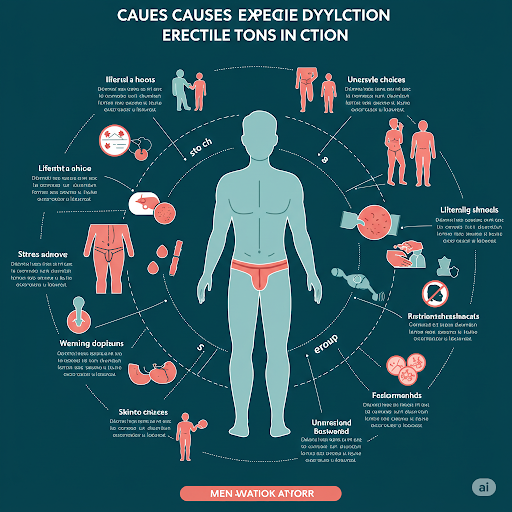Breaking the Myth: ED Is Not Just a Problem for Older Men
Erectile dysfunction (ED) is commonly associated with aging — but more and more men in their 20s and 30s are facing this issue. The stereotype that ED only affects men over 50 can make it difficult for younger men to seek help or even recognize that what they’re experiencing is a medical condition.
The truth is: ED at 30 is real — and often treatable. Understanding the possible causes and taking proactive steps can restore both function and confidence.
What Is Considered Erectile Dysfunction?
ED is defined as the consistent inability to achieve or maintain an erection firm enough for sexual activity. While occasional difficulty is normal (especially under stress or fatigue), if it happens more than 50% of the time, it’s a signal that something needs attention — physically, mentally, or both.
Common Causes of ED in Men Under 40
Erectile dysfunction in younger men is usually not related to aging or chronic disease — although that’s changing due to lifestyle shifts. Below are the most common causes for ED at 30:
1. Performance Anxiety and Psychological Stress
Anxiety is a major culprit for ED in younger men. The pressure to perform, fear of disappointing a partner, or insecurities can create a mental block that disrupts the natural arousal and erection process.
Signs this may be the cause:
- Erections during masturbation are normal, but fail during intercourse
- The issue began suddenly during a stressful time
- You feel “trapped in your head” during sex
2. Depression and Mental Health Disorders
Mental health plays a major role in sexual function. Depression, low self-esteem, and past trauma can lead to low libido or difficulty maintaining erections. Often, the medications used to treat these conditions (like SSRIs) can worsen ED.
3. Porn-Induced ED
Excessive use of pornography, especially over many years, can desensitize the brain’s arousal pathways. This leads to a condition sometimes referred to as “porn-induced erectile dysfunction,” where real-life intimacy fails to stimulate the same level of excitement.
Reducing or stopping porn consumption can often improve the condition over time.
4. Substance Use (Alcohol, Tobacco, Recreational Drugs)
- Alcohol: A depressant that reduces blood flow and interferes with the central nervous system.
- Nicotine: Constricts blood vessels, limiting the blood flow necessary for an erection.
- Cannabis and other recreational drugs: Can alter hormonal balance and desensitize the reward system in the brain.
5. Sedentary Lifestyle and Poor Diet
Being overweight, physically inactive, or having poor cardiovascular health can all contribute to ED. Even at 30, excess belly fat and high cholesterol can slow circulation and hormone regulation.
6. Low Testosterone Levels
Although low testosterone (Low T) is more common with age, it can occur early due to genetics, sleep disorders, or obesity. Symptoms include low libido, fatigue, and reduced muscle mass — along with ED.
7. Underlying Medical Conditions
While less common in younger men, the following conditions can still affect men at 30:
- Diabetes (especially undiagnosed)
- High blood pressure
- Hormonal imbalances
- Peyronie’s disease (scar tissue in the penis)
How to Diagnose and Address ED at 30
Step 1: Identify the Pattern
- Does ED happen consistently or only in certain situations?
- Are morning erections still occurring?
- Is the problem linked to specific partners or settings?
These clues help determine whether the cause is more psychological or physical.
Step 2: Lifestyle Changes
The majority of ED cases in younger men are reversible through lifestyle improvements:
- Exercise regularly: Aim for 3–5 days a week of both cardio and strength training
- Eat a heart-healthy diet: Vegetables, fruits, whole grains, lean proteins
- Sleep at least 7 hours per night
- Limit alcohol and quit smoking
- Reduce stress through mindfulness, therapy, or relaxation techniques
Step 3: Consider Therapy
Performance anxiety, depression, or emotional trauma are best addressed through therapy or counseling. Cognitive Behavioral Therapy (CBT) is particularly effective for treating ED related to anxiety or low self-esteem.
Step 4: Talk to a Doctor
If changes in habits don’t lead to improvement, it’s time to consult a doctor. Blood tests can check hormone levels, and a urologist can assess vascular or nerve-related issues.
It’s crucial to never self-medicate with erectile dysfunction pills without medical supervision, especially at a young age.
Medications for ED at 30: When Are They Appropriate?
Prescription medications like sildenafil (Viagra) or tadalafil (Cialis) can be effective for younger men, but they should not be the first or only line of defense. If the root cause is psychological or lifestyle-related, pills may only mask the symptoms and delay long-term solutions.
Used correctly and under guidance, they can serve as a temporary aid during recovery or therapy.
You’re Not Alone — And You’re Not Broken
ED at 30 can feel confusing and frustrating, but it’s more common than many realize. The silence around male sexual health often causes shame and isolation — but the truth is that it’s highly treatable, especially in younger men.
Confidence Comes From Clarity and Action
If you’re struggling with ED at 30, the best thing you can do is face the issue head-on. Understanding the root causes — whether mental, physical, or a combination — is the first step. With the right support, lifestyle changes, and, if needed, professional help, a satisfying and confident sex life is entirely within reach.
